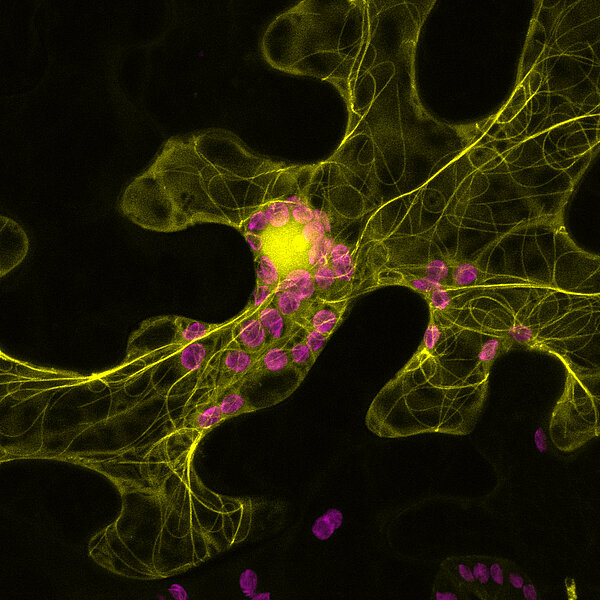Xanthomonas effector protein causes degradation of plant microtubules.
Xanthomonas, as plant pathogenic bacteria, cause enormous damage to crops and ornamentals. They infect more than 400 plant species, including wheat and rice, white cabbage, walnuts, lemons, cotton and soybeans, as well as begonias, geraniums and hyacinths. Over the course of evolution, these pathogens have developed numerous strategies to successfully infect and colonize different plant species. Scientists at IPB and MLU have recently taken a closer look at one of these infection strategies and gathered new insights into this particular mechanism of disease development.
In general, Xanthomonas bacteria gain access to plant tissue through wounds or stomata and, depending on the pathogen type, grow either in the vascular tracts or in the intercellular space between the leaves' mesophyll cells. The bacteria also inject type III effector proteins (T3Es) directly into the cytosol of plant cells via needle-like structures of the type III secretion system. Here, the effector proteins suppress the basal immune response of the plants. This leads to necrotic spots of dead tissue and overall wilting and rotting of leaves and stems in susceptible plants.
Each bacterial strain or pathovar has developed its own arsenal of different effector proteins in interaction with its host plant species. For example, 36 different effector proteins are known for the bacterial spot disease pathogen of tomatoes and peppers Xanthomonas campestris pathovar vesicatoria (also known as X. euvesicatoria), while 24 specific T3Es have been discovered so far in the cabbage pathogen Xanthomonas campestris pv. campestris. Elucidating the diverse biochemical activities of T3Es within plant cells has been the focus of plant research for the past 25 years. Some effector proteins can activate transcription in the host cell, others are able to phosphorylate or ubiquitinate host proteins and thus release them for degradation; however, for many of the T3Es discovered so far, it is still unknown what they do and which plant signaling pathway they interfere with.
Although T3E arsenals are often diverse in structure and action from pathovar to pathovar, some T3Es with conserved structural traits are present in most sequenced Xanthomonas strains. These include Xanthomonas outer protein L (XopL), which is an ancestral effector contributing to the virulence of several Xanthomonas strains infecting different plant species. XopLs exhibit a conserved leucine-rich region and an E3 ligase activity. Despite these conserved characteristics, there is new evidence from scientists in Halle to suggest functional variation exists between the XopLs of different Xanthomonas species. Expression of XopLs in tobacco plants revealed two major findings: that XopLs proteins differ in their ability to induce plant cell death, and that the in planta localization of XopLs proteins is not conserved between Xanthomonas species. This study revealed that the plant cytoskeleton, specifically microtubules, is likely a target for the XopL ligase from three out of the four Xanthomonas species tested.
By comparative sequence analyses of the different XopL proteins, the researchers were finally able to pinpoint a proline-rich and an α-helical region as the structures responsible for microtubule binding of the E3 ligases, and to link microtubule binding and cell death phenotypes. It is not yet clear exactly how these XopL-microtubule interactions lead to the initiation of plant cell death. Microtubules are thought to play a role in signal transduction of plant immune responses and also in certain autophagy degradation and disposal processes. With their study, the scientists demonstrated in an exemplary way that studying an effector protein in the context of a genus rather than a single species can provide important insights into its localization and activity.



